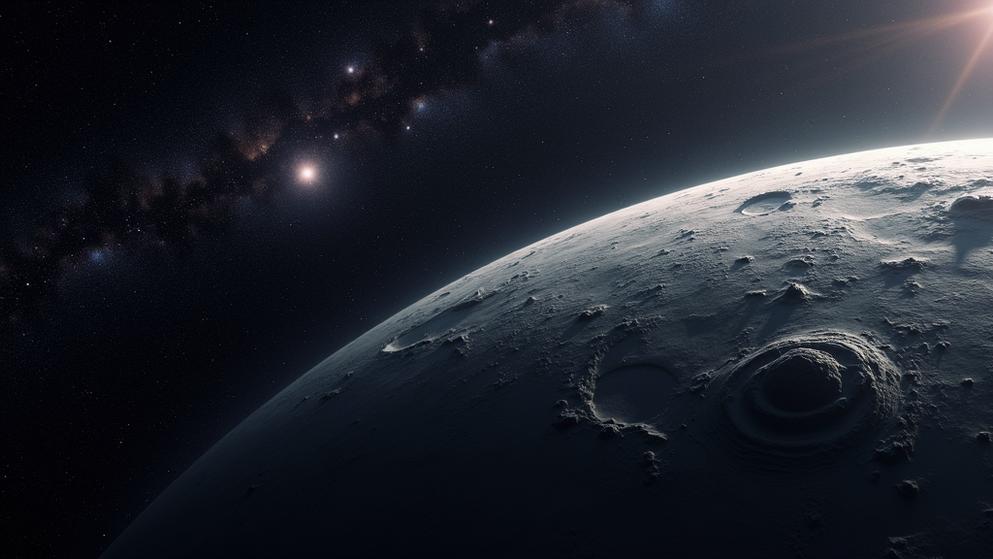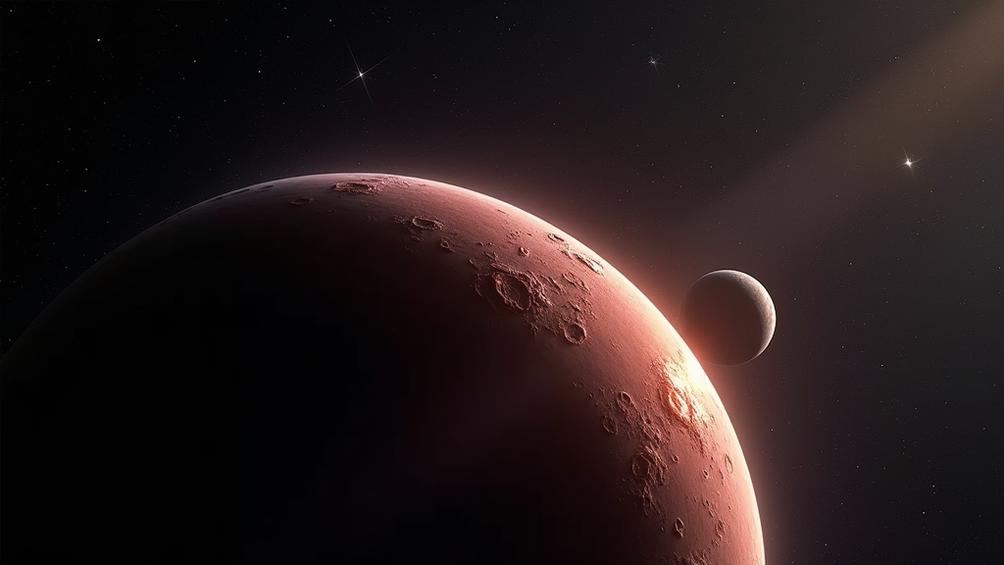Makemake: Definition and Facts
Makemake is a dwarf planet located in the Kuiper Belt beyond Neptune’s orbit. It ranks as the third largest dwarf planet in the solar system with a diameter of 1,430 kilometers. Makemake’s surface consists primarily of methane and ethane ices, giving it a reflective and reddish appearance. The dwarf planet was discovered on March 31, 2005 at the Palomar Observatory by Mike Brown’s team. Makemake has one known moon, S/2015 (136472) 1, discovered by the Hubble Space Telescope in 2015.
Makemake reflects 80% of sunlight. It orbits the Sun at an average distance of 45.8 astronomical units, taking over 305 Earth years to complete one revolution. Makemake’s orbit is eccentric, ranging from 33.7 AU to 53.1 AU from the Sun. The discovery of Makemake contributed to Pluto’s demotion to dwarf planet status in 2006. Scientists continue to study Makemake to uncover more intriguing facts about its nature and composition.
Makemake is classified as a dwarf planet by the International Astronomical Union due to its size and orbital characteristics. Its surface temperature ranges from -233°C to -213°C. Astronomers categorize Makemake as a classical Kuiper Belt object due to its relatively circular orbit. Makemake is the second brightest dwarf planet in the Kuiper Belt after Pluto and the second furthest dwarf planet from the Sun after Eris.
What is Makemake?
Makemake is a dwarf planet in the Kuiper Belt, ranking among the largest known classical Kuiper Belt objects. Its diameter measures approximately 1,430 kilometers, about 60% of Pluto’s size. Makemake possesses one known satellite, S/2015 (136472) 1. The dwarf planet’s surface consists primarily of methane and ethane ices, giving it a reflective, reddish appearance.
Makemake has a diameter of 1,430 kilometers (890 miles). It is among the largest known objects in the Kuiper Belt. Makemake was initially called 2005 FY9 before receiving its official name, which comes from the Rapa Nui god of fertility and creation. Makemake has one known moon, S/2015 (136472) 1, discovered by the Hubble Space Telescope in 2015. The moon has an estimated diameter of 175 kilometers (109 miles).
Does Makemake have moons?
Makemakehas one known moon. Moon 136472 1, nicknamed MK 2, was discovered in 2015 using the Hubble Space Telescope. MK 2 measures approximately 130 miles in diameter and orbits Makemake at a distance of about 13,000 miles.
Makemake’s moon has a diameter of 175 kilometers. It orbits at a distance of 21,000 kilometers from Makemake. The moon completes one orbit around Makemake every 12.4 Earth days. The satellite’s surface likely consists of water ice and darker organic material.
The discovery of Makemake’s moon provided insights into the dwarf planet’s formation and evolution. Makemake underwent intense heating and differentiation in the past, leading to the formation of its satellite. The moon’s presence offers clues about Makemake’s history and composition. Exploration of Makemake’s system highlights the importance of studying Kuiper Belt objects.
Efforts to detect additional satellites around Makemake are ongoing. Currently, no other companions have been confirmed. Astronomers continue to observe Makemake’s system for potential undiscovered moons.
What are the facts about Makemake?
The facts about Makemake are listed below.
- Makemake is the third largest dwarf planet in the solar system, with a diameter of 1,430 kilometers.
- Makemake reflects 80% of sunlight, making it highly reflective and bright in appearance.
- Makemake is located in the Kuiper Belt region, beyond Neptune’s orbit, and is the second furthest dwarf planet from the Sun.
- Makemake takes over 305 Earth years for Makemake to complete one orbit around the Sun, with an average distance of 45.8 astronomical units.
- Makemake’s orbit is highly eccentric, ranging from 33.7 AU to 53.1 AU from the Sun.
- Astronomers discovered Makemake on March 31, 2005, initially nicknaming it “Easterbunny.”
- The discovery of Makemake contributed to Pluto’s demotion to dwarf planet status in 2006.
- The surface of Makemake is composed of frozen methane and ethane ices, contributing to its bright appearance.
- Makemake has one known moon, S/2015 (136472) 1, which was discovered in 2015 and measures about 175 kilometers in diameter.

What kind of planet is Makemake?
Makemake is a dwarf planet in the Kuiper Belt. The International Astronomical Union classifies Makemake as a dwarf planet due to its size and orbital characteristics. Makemake orbits the Sun in 310 Earth years. Makemake’s orbit ranges from 33 to 45 astronomical units from the Sun. Makemake’s surface consists of frozen methane and nitrogen ices.
Astronomers classify Makemake as a classical Kuiper Belt object due to its circular orbit. Makemake is the second brightest dwarf planet in the Kuiper Belt after Pluto and the second furthest dwarf planet from the Sun after Eris. Scientists study Makemake to gain insights into the outer Solar System and expand understanding of the Kuiper Belt.

Why was Makemake called the easter bunny?
Makemake received the “Easter Bunny” nickname due to its discovery timing. Astronomers Brown, Trujillo, and Rabinowitz found Makemake on March 31, 2005, one day before Easter Sunday. Discovery team used “Easterbunny” as internal codename. Researchers gave unofficial name honoring Easter holiday. Public continues using Easter Bunny reference for Makemake’s discovery.
What is the size of Makemake?
Makemake has a diameter of 1,430 miles (2,300 kilometers). Makemake’s radius measures 715 miles (1,150 kilometers). Makemake is approximately 2/3 the size of Pluto. Makemake’s size compares to a nickel as Earth compares to a mustard seed.
The dwarf planet measures two-thirds the size of Pluto. Makemake’s size is significant among Kuiper Belt objects. Astronomers discovered Makemake in 2005, sparking considerable interest in the scientific community. Makemake’s discovery and subsequent size measurements have provided valuable data about dwarf planets and the outer solar system.
What is the Makemake radius?
Makemake’s radius measures 715 kilometers (444 miles). Makemake is the largest known classical Kuiper belt object. Makemake’s diameter is approximately 60% of Pluto’s. Makemake possesses one known satellite. Hubble Space Telescope and ground-based telescopes determined Makemake’s size. Makemake’s radius is similar to Saturn’s moon Iapetus.
Makemake’s size provides information about its composition and properties. Scientists use advanced techniques like occultations and thermal emission modeling to measure Makemake’s dimensions precisely. Makemake’s equatorial radius is approximately 700 meters larger than its polar radius, indicating a slight flattening at the poles.
Where is Makemake located?
Makemake is located in the Kuiper Belt region beyond Neptune’s orbit. Kuiper Belt extends from 30 to 55 astronomical units from the Sun. Makemake orbits between 33 AU and 45 AU. Kuiper Belt contains icy bodies and small celestial objects. Makemake shares this region with dwarf planets Pluto, Haumea, and Eris.
How far is Makemake from the sun?
Makemake orbits the Sun at an average distance of 45.8 astronomical units (au). One au equals 93 million miles or 149.6 million kilometers. Makemake’s distance varies between 27.7 au at perihelion and 45.5 au at aphelion. Makemake takes 310 Earth years to complete one orbit around the Sun.
Makemake was located 52.5 AU or 7.85 billion kilometers from the Sun as of April 2019. Makemake takes 310 Earth years to complete one full orbit around the Sun. Sunlight requires 6 hours and 20 minutes to travel from the Sun to Makemake at its average distance. Makemake has a highly eccentric orbit with a tilt of 29 degrees relative to the solar system’s plane.
What is Makemake made of?
Makemake consists primarily of frozen methane (88%) and nitrogen (12%). Makemake’s surface contains methane and ethane ices mixed with darker organic material. Tholins form a layer on Makemake’s surface. Water ice, rock, and gases exist in smaller amounts. Makemake’s composition resembles other Kuiper Belt objects, providing insights into early solar system formation.
Makemake’s surface is covered in frozen gases. Methane ice is present on Makemake’s surface in high concentrations, making up 50-70% of its composition. Nitrogen ice is found on Makemake’s surface, comprising 20-30% of its makeup. Other frozen gases like carbon monoxide and carbon dioxide account for 1-5% of the surface composition.
Makemake’s surface has a temperature of -243°C (-405°F). The dwarf planet’s surface temperature ranges from 30-40 K (-243 to -233°C). Makemake’s reddish-brown color comes from tholins or organic compounds. These organic materials make up 10-20% of the surface composition.
The Hubble Space Telescope has observed Makemake, revealing its surface characteristics and composition. Makemake does not have a substantial atmosphere. Spectroscopic observations provide data on Makemake’s composition.
What color is Makemake?
Makemake’s surface appears reddish-brownish. Licandro et al. (2006) describe it as moderately red, comparable to other Kuiper Belt Objects. Frozen methane and ethane ices cover the surface, contributing to its color. Tholins, complex organic molecules formed by methane and UV radiation, give Makemake its distinctive reddish hue. Hromakina et al. (2019) observed color variations across the surface.
Makemake’s B-V color index is 1.1, indicating a significant difference between its blue and visual magnitudes. This color index is consistent with the observed reddish-brown appearance of the dwarf planet. Makemake’s coloration is similar to that of Pluto, highlighting the diversity of surface colors among Kuiper Belt objects.
How long is a day on Makemake?
Makemake completes one rotation in 22.5 hours. Makemake’s day length is shorter compared to other Kuiper Belt dwarf planets. Makemake’s day length is similar to Earth’s and Mars’. Makemake’s short day length contributes to extremely cold surface temperatures, dropping to -233°C. Makemake’s rotation period is tidally locked to the Sun.
Makemake spins on its axis at a slow rate. The dwarf planet’s day length is shorter than its orbital period around the Sun. Makemake orbits the Sun at an average distance of 33.7 astronomical units (AU). Makemake takes 310 Earth years to complete one orbit around the Sun.
What orbit does Makemake follow?
Makemake follows an orbit inclined 29 degrees to the solar system plane. Makemake’s orbit has 0.16 eccentricity, varying its distance from the Sun. Makemake reaches perihelion at 33.5 AU and aphelion at 45.5 AU. Makemake orbits the Sun like other Kuiper Belt objects beyond Neptune’s orbit.

